Puget Systems Serenity SPCR Edition: Blissful Silence
by Dustin Sklavos on February 10, 2011 12:00 AM EST- Posted in
- Systems
- Intel
- Radeon
- Sandy Bridge
- Puget Systems
- Serenity SPCR
Application and Futuremark Performance
At this point it goes without saying that Sandy Bridge is fast, but this time around we have a stock-clocked system contending with both an overclocked Sandy Bridge unit and quite a few systems featuring some overclocked representatives of last generation's finest. While you're looking at these benchmarks, though, try to remember that Puget Systems tuned the Serenity SPCR Edition for maximum silence. The Intel Core i5-2500K hasn't been touched, and the PowerColor Radeon HD 5750 included is tied for the fastest passively-cooled video card on the market. You can hear all of the other systems here under load, but you can't hear the Serenity.
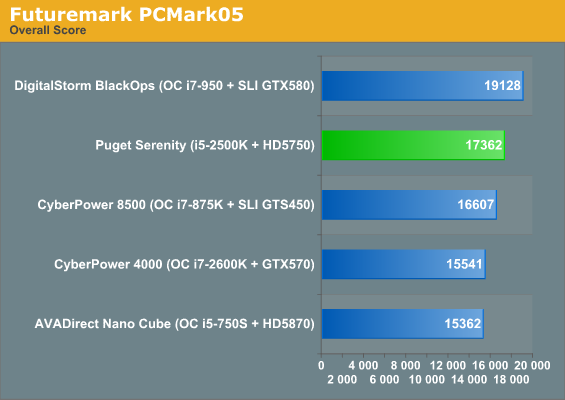
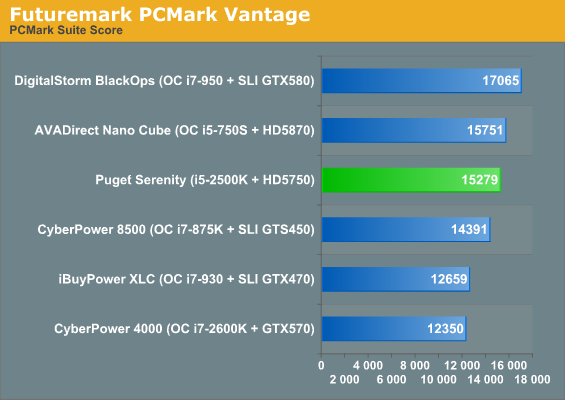
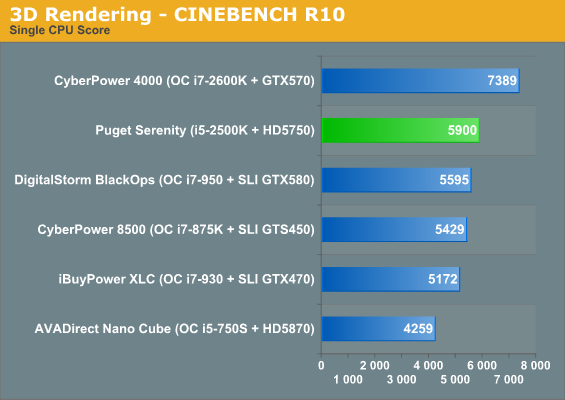
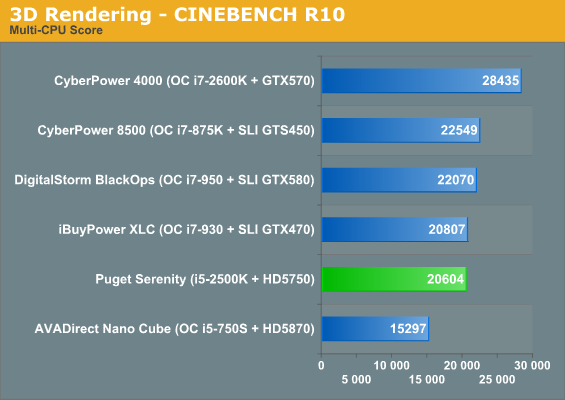
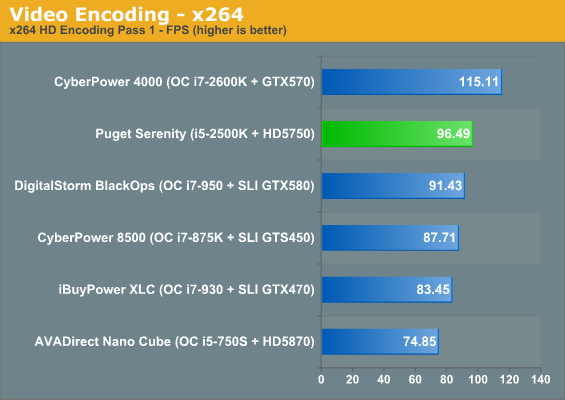

As you can see, even at stock clocks with no Hyper-Threading, it still takes a lot to hold Sandy Bridge down. The DigitalStorm and CyberPower 8500 systems are both running their processors at 3.8GHz, and DigitalStorm's tower has the added benefit of triple-channel memory. In fact the only chips that aren't Hyper-Threaded are the i5-2500K and the i5-750S, and while the i5-750S basically trails the competition here, the i5-2500K's worst showings still mostly nip at the heels of the 3.5GHz processor inside the iBuyPower XLC.
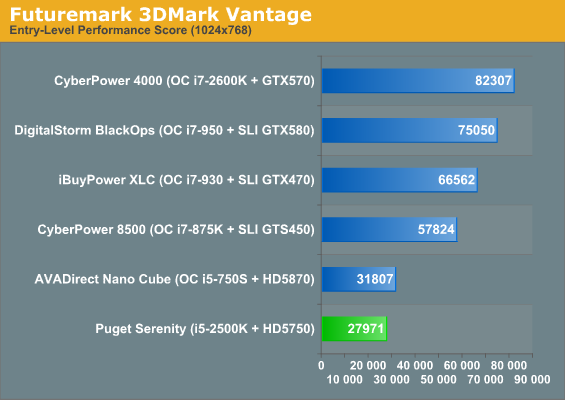
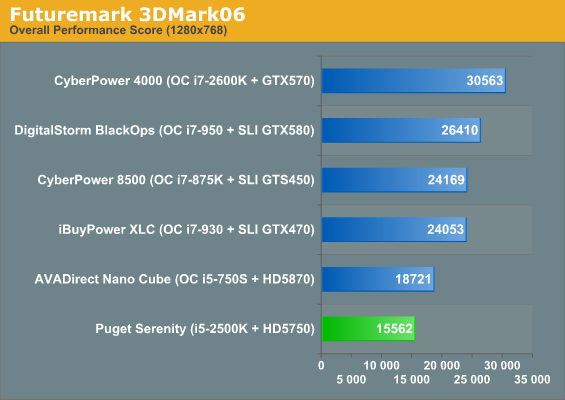

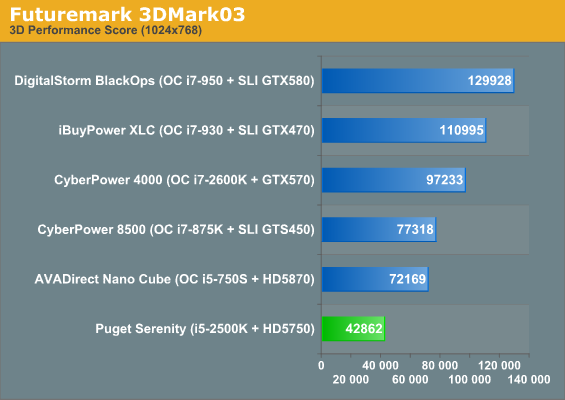
3DMark is less kind to the Puget Systems Serenity, but it still posts a strong showing and as we'll see the 5750 at its heart is for the most part able to game at 1080p. Again, remember that the Serenity is basically inaudible during gaming sessions and power consumption is remarkably low, as you'll see later. Of course, if the 5750 just doesn't cut it for you it's worth repeating that Puget Systems is working on getting a passively-cooled Radeon HD 6850 in house. It's entirely possible that by the time they can start shipping Sandy Bridge-based systems like this one again you'll actually be able to make that upgrade.










139 Comments
View All Comments
Kaleid - Friday, February 11, 2011 - link
should have a 500rpm fan added to it, 79C is not cool.flemeister - Friday, February 11, 2011 - link
It's well within spec. Also, a fan mounted on the video card would need to be mounted horizontally, which would encourage ticking/scraping noises from the fan (I've got a similar rig, gone through this stage before). These noises would be noticeable in a rig this quiet.And if you choose a fan that's not susceptible to such noises, you encounter motor noise, a buzzing sound that reminds you why Puget chose the sleeve-bearing Scythe Slipstream fans - they sound absolutely perfect: no buzzing, no unwanted noise at all. I'm using three of the 800RPM models in my rig as we speak, and I couldn't be happier with them!
coffeejunkee - Friday, February 11, 2011 - link
Nice try but there is only one way to go with this configuration: Thermalright HR-02 on the cpu and HR-03 GT on the gpu. It won't get more quiet than this.Chris Peredun - Friday, February 11, 2011 - link
I know Dustin didn't want to go into the "30fps" discussion, but I'm really, really tired of seeing that statement getting bandied about the Internet.There is a very, very clear difference between 60 and 30fps. If you disagree, I'm afraid you are simply wrong.
There.
I said it.
*draws line in the sand*
Dustin Sklavos - Saturday, February 12, 2011 - link
There absolutely is and I believe I suggested as much.That said, in my experience (and for most of the industry) 30fps seems to be the magic number for playable smooth framerate in gaming. Certain games look like crap at 30, though, while others (Crysis) can actually dip below it and still feel pretty smooth.
Chris Peredun - Saturday, February 12, 2011 - link
*shakes head and respectfully gestures to the other side of the line*The confusion is that ~24fps (and around 30fps) is the lower threshold of motion, where you stop seeing individual frames and start seeing continuous movement.
Yes, 30fps is smooth. Yes, it's playable. But 60fps is noticably better, especially when the game is fast-paced. Something like WoW won't suffer nearly as bad as a twitch FPS, for example.
The easiest way to relate the 60-vs-30 argument is to ask people if they can see the difference between something like a live-action sports event or soap-opera (both typically shot and broadcast 60fps) and a "major network TV show" typically shot and broadcast at 24/30fps.
Or have a look at the sample video here, recorded from Way Back When UT2004 was considered new:
http://kimpix.net/2006/12/03/60fps-vs-24fps/
If you're *happy* with 30fps, you've probably saved a lot of money on video cards over the years by not needing anything above that. But please don't try to write it off as an academic difference. 100 vs 150, I'll accept as being academic simply because most people still run 60Hz monitors.
ClagMaster - Sunday, February 13, 2011 - link
"And finally, a brief thumbs up for including 8GB of DDR3 instead of 4GB in the review unit. This really should be standard and it's perplexing why so many of our review towers don't ship with 8GB at this point."Thats mighty magnamimous of you that you gove a "brief thumbs up" have 8 GB of memory on your review unit.
Your comment is silly.
I seriously wonder if you ever used over 30% (2.4 GB) of that memory in your test reviews.
There are plenty of people who have used PC's for 25 years who consider 32-bit Operating Systems and 4 GB of DDR3 memory more than adequate for most mainstream applications which includes DVD and BlueRay encoding.
How about you load a 32-bit Windows XP Home or Pro OS on this nice quiet Sandy Bridge Boutique PC with 4 GB of DDR3 memory and see how much more efficient this computer would be.
Just do it and post the results.
HangFire - Tuesday, February 15, 2011 - link
"Just do it and post the results."I hope they do.
I've run XP and 7 on identical systems, and even the same system. XP has inexplicable delays in bootup and network operations that don't plague 7. Having an extra 4GB of dynamically available disk cache really helps in SSD/HDD systems.
xbmchtpcfan - Sunday, February 13, 2011 - link
I think one important aspect that everyone is failing to call out is what is your time worth to you? Many of you talk about putting together your own rig for cheaper, yet fail to realize you are spending your time to do that. What is that time worth to you? Many of you will just chalk this time up to a 'hobby', but I have lots of hobbies, spending time with my family and friends among the top.And yes, I am technically competent enough to order all the parts and put a somewhat silent machine together for a cheaper base cost. But between researching, ordering the parts, assembling, testing, etc, how much time will I really put into this?
Since most of you want to put dollars next to it, I'll give an example of something with dollar value. If you could consult in your field of expertise, is the 30 hours spent better than consulting on the side for, say, $50 an hour? Now your opportunity cost is $1500 of lost revenue vs an additional cost of $700 (rough estimates) for the Puget system.
Given the above example, many of you will say that if you are able to consult for $50 an hour outside of your normal day job, than you can probably afford to pay whatever you want, so let's take look at non-monetary examples. Is it time better spent than staining your deck? Landscaping? Is it time better spent than reading to your daughter or watching her walk for the first time?
The answer to all of these may be yes to you, but to others, they may have different priorities and different hobbies that they like to do. If you want to know what types of target consumers Puget is looking for, it's the ones that realize that their time is worth something and that there is an opportunity cost associated with anything that requires your time and effort.
As for me, I am in this market, so for me, it is about reviewing all the boutique shops that offer this type of quiet machine and factoring in everything they have to offer based on the price of the system. From what I can tell, Puget is near or at the top of the list. I'll likely wait for the Sandy Bridge fiasco to blow over and see what Puget does with the Radeon HD 6850 to get a little more gaming power out of a silent machine. So there you have it, one AT reader that is in the target market.